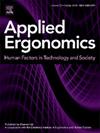Influence of seating orientation on motion sickness in autonomous vehicles
IF 3.4
2区 工程技术
Q2 ENGINEERING, INDUSTRIAL
引用次数: 0
Abstract
A major advantage of autonomous vehicles (AVs) is the passengers’ ability to perform non-driving related tasks (NDRTs) while being driven. Among these NDRTs, social interaction with other passengers is considered to be particularly valuable. Seating layouts featuring rotatable front seats will enable a new level of social interaction during autonomous car journeys. However, being seated against the direction of travel is not very popular. Fear of motion sickness is one of the main reasons for this reluctance, which is commonly explained by the inability to see the road ahead. This raises the question to what extent motion sickness in rearward facing passengers of autonomous vehicles is to be expected and to what degree this is caused by the inability to see through the windscreen. To answer this question, a field experiment in real traffic with N = 55 participants was conducted. Seating orientation and forward view were manipulated and their effects on motion sickness as well as related factors relevant to the acceptance of AVs were analyzed. Both a rearward seating orientation and a restricted forward view led to significantly increased motion sickness. The insights gained serve as a basis for the development of HMIs that improve the acceptance of rearward facing seating orientations in AVs.
自动驾驶汽车座椅朝向对晕动病的影响
自动驾驶汽车(AVs)的一个主要优势是乘客能够在驾驶过程中执行与驾驶无关的任务(NDRTs)。在这些ndrt中,与其他乘客的社会互动被认为特别有价值。以可旋转前排座椅为特色的座位布局将使自动驾驶汽车旅程中的社交互动达到一个新的水平。然而,逆着旅行方向坐是不太受欢迎的。对晕动病的恐惧是这种不情愿的主要原因之一,这通常被解释为看不到前面的路。这就提出了一个问题,即自动驾驶汽车的后排乘客晕车在多大程度上是可以预期的,以及这在多大程度上是由于无法透过挡风玻璃看到东西造成的。为了回答这个问题,我们在真实交通中进行了一项有55名参与者的现场实验。通过对座椅方向和前视进行控制,分析其对晕动病的影响以及自动驾驶汽车接受度的相关因素。向后的座位和受限的前视都会显著增加晕动病。所获得的见解可作为开发hmi的基础,以提高自动驾驶汽车对向后座椅方向的接受度。
本文章由计算机程序翻译,如有差异,请以英文原文为准。
求助全文
约1分钟内获得全文
求助全文
来源期刊

Applied Ergonomics
工程技术-工程:工业
CiteScore
7.50
自引率
9.40%
发文量
248
审稿时长
53 days
期刊介绍:
Applied Ergonomics is aimed at ergonomists and all those interested in applying ergonomics/human factors in the design, planning and management of technical and social systems at work or leisure. Readership is truly international with subscribers in over 50 countries. Professionals for whom Applied Ergonomics is of interest include: ergonomists, designers, industrial engineers, health and safety specialists, systems engineers, design engineers, organizational psychologists, occupational health specialists and human-computer interaction specialists.
 求助内容:
求助内容: 应助结果提醒方式:
应助结果提醒方式:


